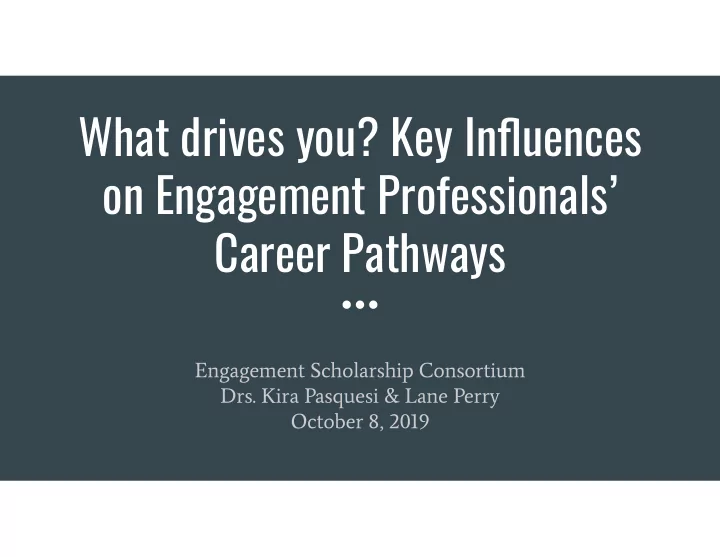

What drives you? Key Influences on Engagement Professionals’ Career Pathways Engagement Scholarship Consortium Drs. Kira Pasquesi & Lane Perry October 8, 2019
Review of Agenda I. Opening reflection II. Study overview A. Purpose B. Review of literature C. Methods D. Findings III. Small group discussion IV. Now what?
What is your long-term career objective?
Community Engagement Professionals (CEPs) administratively support engagement between a college or university and their broader communities.
Career Development & Faculty Engagement Student Affairs Motivations for community-engaged practices (e.g., O’Meara, 2008) Boundaryless and protean careers (e.g., Briscoe & Hall, 2006) Benefits of engagement (e.g., Hou & Wilder, 2015) Cosmopolitans and locals (e.g., Gouldner, 1957; Rhoades, Kiyama, Limiting and liberating structures in McCormick, & Quiroz, 2008) higher education (e.g., O’Meara, Sandmann, Saltmarsh, & Giles, 2011) Student affairs new professionals, mid-level administrators, & career Best practices for faculty development trajectories of senior student affairs (e.g., Bringle & Hatcher, 1995) officers (Biddix, 2013)
Study Overview Purpose of the study was to examine long-term career objectives of CEPs in higher education 1. Descriptive RQ: What are the long-term career objectives of CEPs? 2. Exploratory RQ: What factors may be influencing CEPs’ long-term career objectives? Study described the long-term career objectives of CEPs and inferred emergent career drivers informing professional pathways
Research Methods Consensual Qualitative Research is a deliberative process of consensus building among researchers to inductively code data (Hill, Thompson, & Williams, 1997) Data set included 314 responses to an open-ended survey question as part of a study used to refine the preliminary competency model (Dostilio et al., 2017) 1. Individual open coding 2. Patterns during team meetings 3. Representations (emergent career drivers) Outside auditor reviewed raw data and preliminary findings
Opportunity- and Role-based Driver Long-term career objectives driven by promotion within “Aspire to have a senior an institution or related cabinet career trajectory, professional position for community–campus mobility, and/or set of relations.” responsibilities.
Values-based Driver Long-term career objectives “To make a driven by intrinsic worth, meaningful meaning, and importance of contribution to intentional engagement with social change.” students, faculty, staff, and community partners.
Place-based Driver Long-term career objectives “To strengthen the driven by connectedness to a community/ specific place, space, college connection community, or geographic with this city” location.
Profession- and Field-based Driver Long-term career objectives driven by purpose in the “To be part of a mission driven wider field of the public organization that is service mission of higher advancing the public education and the emergent purpose of higher education.” field of the CEP.
Four Corners Discussion Look back at your response to the opening question. What driver best describes your response? Move to the corresponding driver sign / corner of the room. As a small group, discuss: 1. In what ways does the driver inform how you approach or think about your work as a CEP? 2. How might the career driver support your daily decision-making or how you navigate your role as a CEP?
Now what? Implications for Practice
Future Research What’s missing from the model of CEP career drivers? What questions, curiosities, or inquiries about CEP career pathways are you left with? What else would you like the team of researchers to know about your reactions to the study?
Kira Pasquesi kira.pasquesi@colorado.edu Lane Perry laneperry@wcu.edu
Biddix, J. P. (2013). Directors, deans, doctors, divergers: The four career paths of SSAOs. Journal of College Student Development, 54 (3), 315–321. Bringle, R. G., & Hatcher, J. A. (1995). A service-learning curriculum for faculty. Michigan Journal of Community Service Learning, 2 (1),112–122. Briscoe, J. P., & Hall, D. T. (2006). The interplay of boundaryless and protean careers: Combinations and implications. Journal of Vocational Behavior, 69 (1), 4–18. Dostilio, L.D. (Ed.), The community engagement professional in higher education: A competency model for an emerging field . Boston, MA: Campus Compact. Hill, C. E., Knox, S., Thompson, B. J., Williams, E. N., Hess, S. A., & Ladany, N. (2005). Consensual qualitative research: An update. Journal of Counseling Psychology, 52 (2), 196–205. Hill, C. E., Thompson, B. J., & Williams, E. N. (1997). A guide to conducting consensual qualitative research. The Counseling Psychologist, 25 (4), 517–572. Hou, S. I., & Wilder, S. (2015). Changing pedagogy: Faculty adoption of service-learning: Motivations, barriers, and strategies among service- learning faculty at a public research institution. SAGE Open, 5 (1), 1–7. O’Meara, K. (2008). Motivation for faculty community engagement: Learning from exemplars. Journal of Higher Education Outreach and Engagement, 12 (1), 7–29. O’Meara, K., Sandmann, L. R., Saltmarsh, J., & Giles, D. E. (2011). Studying the professional lives and work of faculty involved in community engagement. Innovative Higher Education, 36 (2), 83–96. Rhoades, G., Kiyama, J. M., McCormick, R., & Quiroz, M. (2008). Local cosmopolitans and cosmopolitan locals: New models of professionals in the academy. Review of Higher Education, 31 (2), 209–235.
Recommend
More recommend